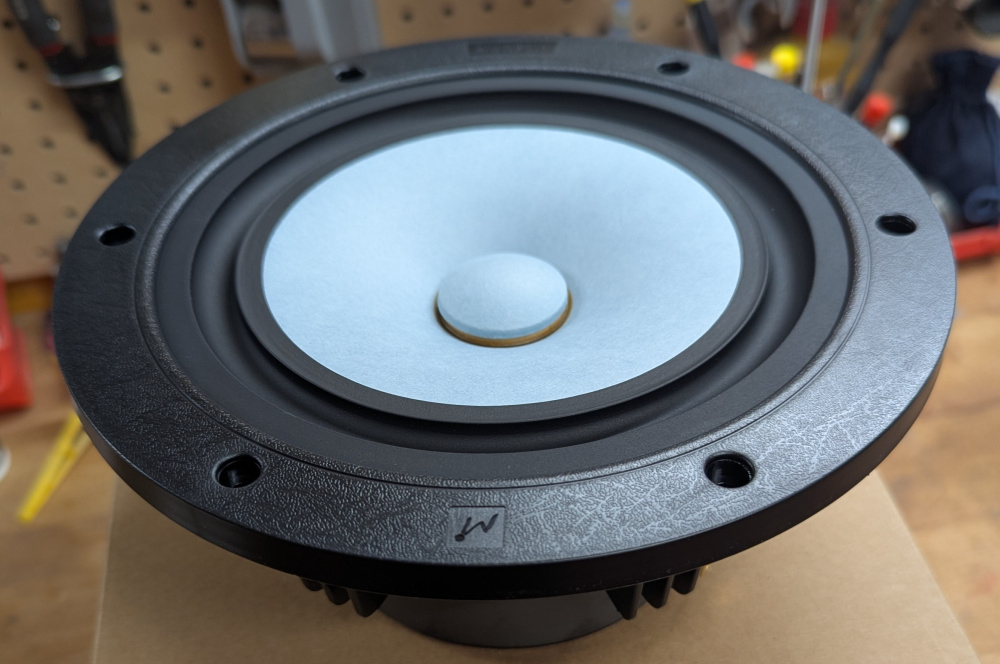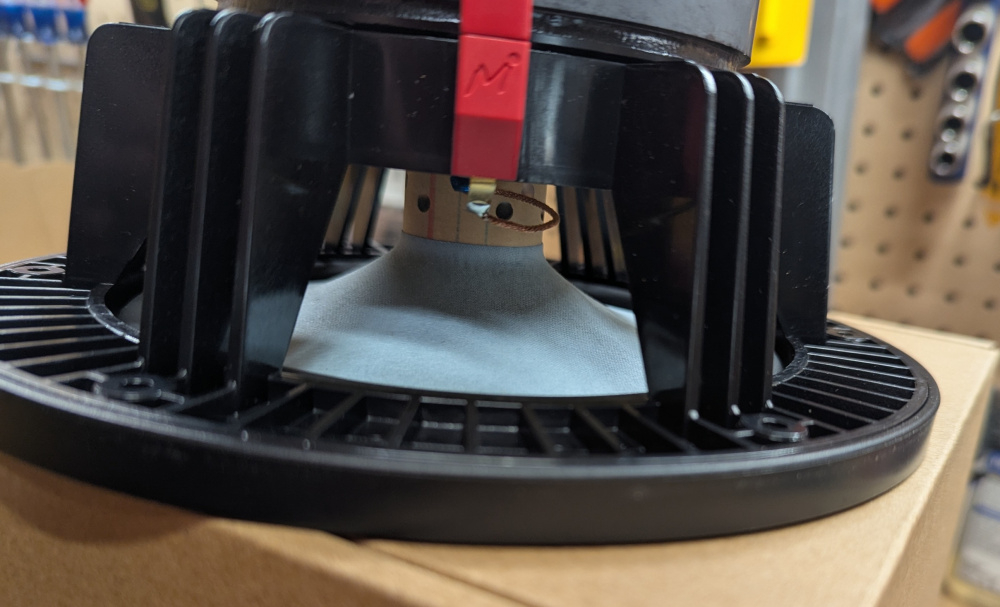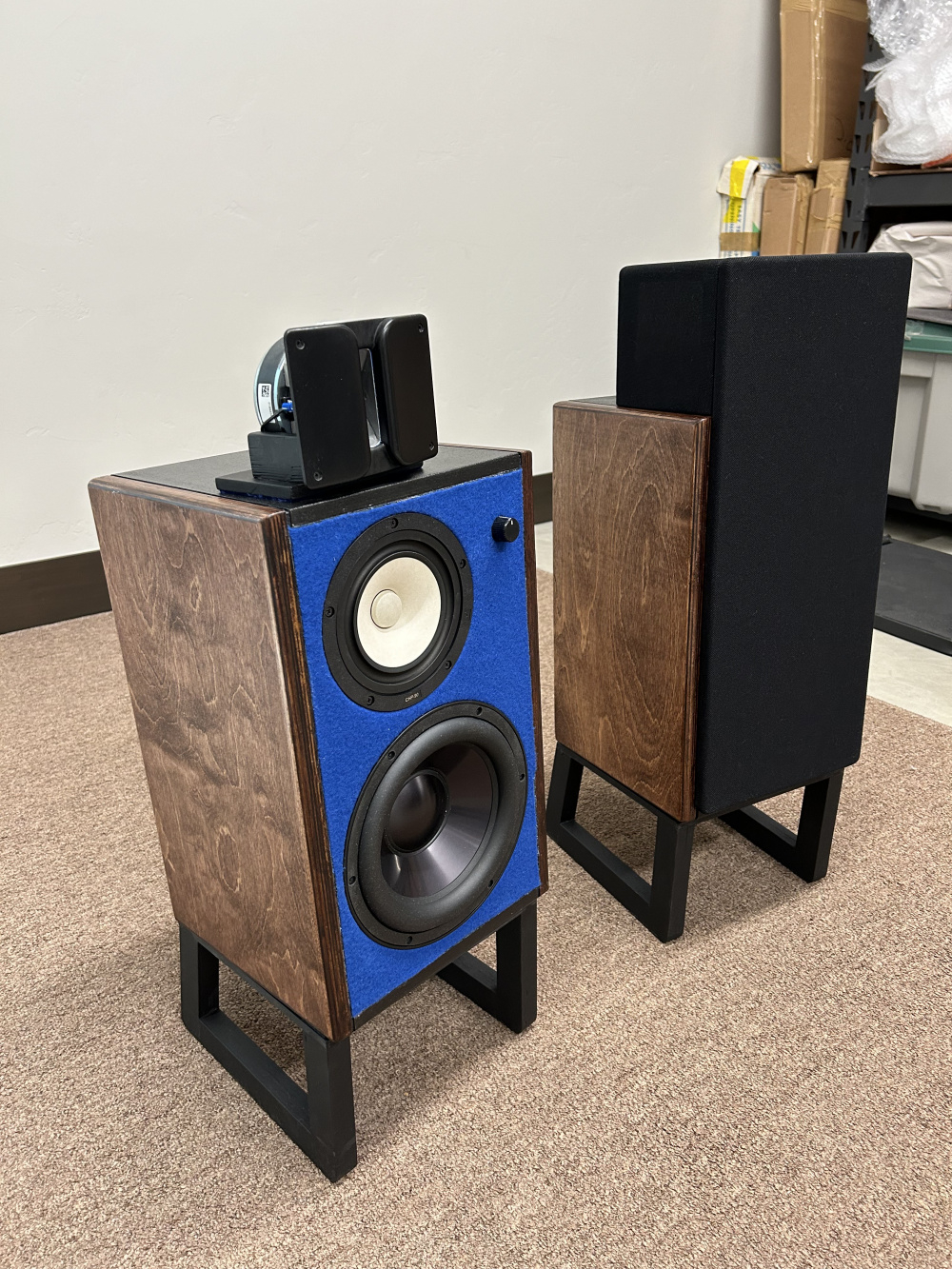Site Links
Howdy, Stranger!
It looks like you're new here. If you want to get involved, click one of these buttons!
Quick Links
Categories
In this Discussion
Who's Online (0)
Mark Audio Alpair 12P
I had a look through the PE Board and changed over to MAC/DIY. Almost everyone is here!
I've started a full range science project that may interest some.
During the 2025 InDIYana, we chatted a bit about FR drivers as they were they were part of the theme.
So I purchased some Alpair 12P's to play with from Mad.
This project has several goals.
1.) Do the full Mark Audio break-in and see if they sound better afterwards.
1a.) My opinion says not. However, opinions ain't scientific. So here we go!
2.) Measure them and build a nice project without fundamentally altering the character.
2a.) Don't force the driver! Maintain as much sensitivity as possible.
2b.) No SPL haircuts to get it flat.
3.) Try out a cool new enclosure finish (for me).
According to Mark Audio, these require a 500 hour break-in / burn-in period.
This is very carefully scripted. ![]()
No artificial signals please, no pink noise, no one-hour excursions to Xmax with a signal at Fs.
Okay, but it sounds weird and painful and has been very slow.
Here is a Robert summary of the break-in period. Most fluff removed.
0-100 hours <= 1mm Xmax on driver at all times. Movement should not be constant.
Conduct 6 hour break-ins with 30 minute cooldown.
Avg volume low 70dB range for a single driver.
Minimal percussion, bass, and cone movement.
Level should be of background music you can easily talk over without raising your voice.
I've been using light jazz, string quartets, bluegrass, and Mozart.
The cats like Mozart.
100-300 hours
Max 1-2mm Xmax on driver at all times. No constant excursions or thump.
Same stuff as 0-100 hours with higher SPL. 4 hour break-ins with 30 minute cooldown.
Avg volume low 80dB range with 86dB peaks.
300 to 500 Hours
Volume: Continue using care and avoid excessive volume or bass loads, even though the drivers are reaching full optimization.
This one is dodgy. I decided to use the same 4-hour break-in period as 100-300 hours, with a little rock/pop.
Or a small amount of thump. I'll aim for occasional 3-3.5mm Xmax.
There is another break-in at 500-800, but it's more "at 800 it sounds best" than anything else.
I'm currently conducting the break-in and am at 63 hours. Sigh.
The drivers have CCAW voice coils - aluminum wire. So heating could be an issue at high SPL.
I checked temperature where the former meets the spider with a laser thermometer.
Room temp, as you would expect. No heat rise measured.
I'll continue to do this as SPL increases but I'm thinking it will only be an issue at 1W+.
Driver observations.
* These are marketed as 8 inch drivers. They ain't.
* They are a 6.5 in an 8-inch frame. Sd is 147cm2. Huge flange.
* Frame is plastic. This might be good for resonance suppression, but takes away from a "high-end" look.
* The driver motors are extremely frail-looking (see pic). Shawn called them "dainty." The spider is different.
* The rubber surrounds are air-thin - I MEAN THIN. Be careful picking them up by the flange.
* Qms is very low - 1.981. Cone mass is 10 grams. I've seen lighter cones, but only on top-line drivers like Scans. And they have way more Qms.
* Very sensitive driver - they play quite loud with the amp at -40dB.
* Running raw on the Hi-Fi stand in the living room, they are surprisingly listenable. Maybe Test 1 for a FR driver?
Subjective Stuff.
Note: I wash my ears with my Zaph Audio ZRT's regularly to ensure I am not acclimating to a sub-par driver.
Acclimation has been refused to keep this subjective stuff as objective as possible.
- They do a banjo sitting raw in the room like you are next to it. Subjectively, they sound fast. Plucked strings great.
- There are some FR issues that'll need to be addressed.
- Do they sound better at 63 hours than out of the box? I "think" so, but we'll wait to call that a ground truth.
- It's hard to judge a raw driver on a table. Cancellations/reflections/etc. Mozart sounded nice from them.
- When you put your ear to the cone, inside cancellation region, the bass sounds nice and clean.
Cheers / Robert (at 63 hours)






Comments
Pics

Good to see you here too, Robert!
I look fwd to your observations...
InDIYana Event Website
Maybe because my hearing is less than perfect, or maybe because they actually sound good, but I'm a fan of Mark Audio drivers. I've built a number of them and have enjoyed all of them. They have their limitations I'm sure, but the simplicity and whatever my ears are tickled by make them very pleasing to me. My latest build is a MA 12PW with a MA A7P in a large onken enclosure. I'm very happy with them. I've also recently built a large double mouth horn with a MA A10, which is very enjoyable.
Post pics, please! Let's make a Mark thread.
As I said, as a raw driver sitting on a table or the floor, they sound quite good, and have a quality of speed or snap to them that's nice to listen to - banjo and mandolin are good just plain from the cone. They are going to do bluegrass, acoustic jazz, and quartets nicely. Thick, multi-track studio music remains to be seen.
I took a break from the break-in because** I needed it** and will be using the latest DATS to measure drivers at the break-in milestones. Didn't have DATS when i unboxed them, so the first will be at 100 hours.
I got my old receiver out so that the break-in can be done in a back room. The process was intrusive and honking off Wendy. W loves bluegrass but can't stand broken rhythms like riffy jazz.
I looked at all of their drivers and IMHO, the standout was the CHN-110. I wanted to do a larger driver, though, and the 12P's were the newest.
Cheers / Robert
I used MA’s CHP90s (paper composite cone) in my 3-ways, ran them ~as 4-midables (extended midrange up to the slot super tweeter). As broad-rangers go, these have excellent Xmax, and handle the extended midrange nicely, imo.

Based on what we talked about earlier, I’ve gotten even more excited about these things. It’s made me think more than thrice about doing a full range design. Can’t afford Alpair 12s but I’m going to keep my eyes peeled for something less expensive.
shawn
Besides Markaudio, I’m a fan of Audio Nirvana, at least their 6.5s, which it looks like they don’t offer anymore ? And sorry, not necessarily less expensive than MA’s. But check out their website for a few ideas.
https://www.commonsenseaudio.com/nirvana.html
Maybe give consideration to a mass loaded transmission line design ?
Nice Looking and I love the grilles!
I think I'm going the "small reflex plus sub(s)" route. Makes them tote-able.
On to part 2 of the Post. I just reached 100 hours this morning and broke out DATS for Free air parameters, Vas, Mms, and the very cool Voice Coil Buzz/Rubbing test.
I have the volume dialed up a bit for part 2 of the break-in.
T/S Parameters Below for 4 samples.
Vas and Mms were calculated with a Test Box of 0.512 cubic feet.
T/S parameters are remarkably close between drivers. Additionally, all 4 drivers aced the Voice Coil Rub/Buzz test. There is some break-in happening, as Fs has dropped an average of 1.5Hz on the sample.
OK - on to the next thing. See attached driver datasheet for raw frequency response and impedance plot.
Then see DATS impedance plot below. I also located a harmonic distortion measurement by Bob Brines that gibes with the DATS impedance plot. Not pretty.
Not sure what is going on here, but it sure looks like the Impedance plot on the data sheet doesn't match any of my samples. I won't speculate further, but I don't think the DATS plot I verified 8 times is good advertising copy. I also held the drivers vertically to see if it was some kind of surface reflection. Not.
Given the cost of these, I may reach out to the vendor and see if I can do an exchange. Not certain if I want to go ahead with it now. Distortion 20dB down in the vocal range is tough to swallow, given the cost. It has also really lowered the "exciting project" feeling I had.
Some caveats: full range drivers operate via cone breakup. It's what they do.
You can't expect a really smooth FR and flat impedance plot. However, a major node like this is something else entirely. I've never built a speaker with anything that looked like the DATS plot above.
Robert
If you have them in a test box, measure frequency sweep at say 30 inches (maybe 10 to 15 degrees off ctr) and listen to them. Alone, and then crossed to your sub (could try a level-line hp / capacitor ~ 60 - 80Hz, if you know the input capacitance of your amp). You may be pleasantly surprised (or not), but let your ears decide.
You could also add a broad but shallow notch ~3000Hz, but that’s down the road.
Black line is "THD" right? I don't tend to put much thought into that. Only thing that looks like above the 40db down mark is a few 2nd order peaks which isn't necessarily bad. That could be due to nulls in the response too. Can't tell with a flattened fundamental.
If that DATs output shows both drivers then they match up with that resonance just over 400hz. If one had that but the other didn't then I'd say there is something wrong with one of them. But since both do I imagine that is "normal" for them. Often it seems resonances are leveraged on FR drivers to fill in the response.
Lot of fans of the SB Acoustics SB20FRPC30 8" full ranger at diyaudio IIRC. That'd be my pick. My favorite Mark Audio driver was the EL70 but sadly it got discontinued after only a short run.
I contacted the mfr via the vendor, we'll see what they say.
Still knocking ideas around with the drivers.
Interested in what the mfr will say about the spec sheets.
Next DATS measurement at 200 Hours.
Wendy and I are doing yardwork in-between Noah's floods, so I've been running them 4 hours on / 1 hour off per the scripted break-in procedure.
Cheers / Robert
Here we are at 200 hours, with slightly increased break-in SPL throughout the second half of this multi-quarter event! The drivers show almost no change, and the not shown Z peak on all the drivers at 411-460Hz is more or less the same.
I am starting a plant rebuild tomorrow for work so into their boxes they went.
DATS measurements below. I noted slight differences between measurements but these are more or less even across the samples and so are probably slight test equipment variations.
I did locate a Nelson Pass article on higher efficiency full range speaks (attached) that offers a reason why drivers like this are popular with the vacuum tube crowd. And it has measurements to back it up. Since I have access to a Zen Triode SET, the Alpairs may get a chance to sound a bit better than they measure. Or not. Read at your peril
Shawn is looking at some possible tweaks on these, though questions abound concerning the Z peak at 450Hz. Whatta do about that? Series Notch? It may level the Z for the amp or any upstream components, but will it have any effect on the driver? A series notch will likely be tried, just to see.
On the totally subjective "do they sound any better?" Well, hard to say but possibly so. It is hard to tell what is better and what is getting used to something.
Cheers / Robert
The series notch across the driver to minimize the spike will only affect the impedance if there is no voltage divider out in front of the notch/driver.
InDIYana Event Website
Yup. It may not be easily attacked.